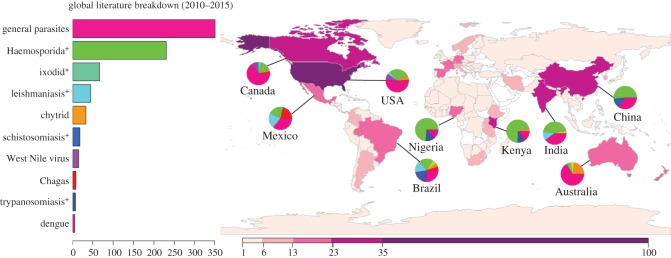Figure 1.
Global distribution of parasite climate change research. Research on parasitic species is disproportionately oriented towards human emerging infectious diseases (EIDs), especially in countries where the majority of parasite research occurs. The figure shows the distribution of 649 studies on parasite ecology (excluding pest management, plant parasites, and reviews, reducing 2200+ studies from Web of Science between 2010 and 2015 featuring the keywords ‘parasite’ and ‘climate change’ down to relevant primary literature) by country and by study system. To illustrate the disciplinary focus on EIDs, major research topics such as haemosporidian blood parasites (primarily malaria) and ixodid ticks and diseases they carry (such as Lyme borreliosis) are separated out from general parasite ecology studies. Global and continental modelling papers were not plotted as they only amplified the focus on major infectious diseases. Combined with a few other diseases such as leishmaniasis, schistosomiasis and trypanosomiasis (and associated vectors and reservoir hosts for each, shown with a ‘+’), the major human EIDs easily match the volume of the entire remainder of climate change literature within parasitology as a discipline. Even in this small subset of the literature, the asymmetry of parasite ecology studies as they relate to climate change is evident.

